Outbreak of World War II and its Impact in Colonies | History - Chinese Revolution, 1949 | 12th History : Chapter 14 : Outbreak of World War II and its Impact in Colonies
Chapter: 12th History : Chapter 14 : Outbreak of World War II and its Impact in Colonies
Chinese Revolution, 1949
Chinese Revolution, 1949
China had a long history and through most of
historical times was more advanced than Europe. But by 1900, China had lagged
behind on most fronts. A particular reason for its downfall was the long
corrupt and inept rule of Manchu dynasty since 1650. The landed gentry produced
scholar officials called mandarins, who defended the established order with
privileged status. The mass of the population, the peasants, suffered from high
rents, high taxes and shortage of land. Agricultural production was stagnant.
Cultivated areas were densely populated, with the average size of a farm
remaining less than an acre. Although China possessed coal and iron ore in abundance,
industrial development was slow.
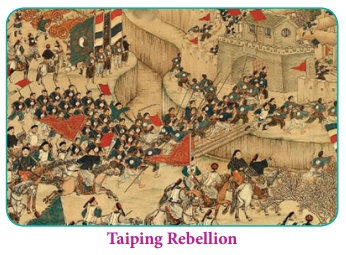
The oppressive political and economic system
triggered a number of risings during the nineteenth century. The most serious
was the Taiping Rebellion (1850–1864). That it took fourteen years for the
government to crush was an indication of the weakness of the government.
Growing European pressure, first the British, and then the French, Germans,
Russians and Americans, forced China to cede trading rights at ports to
foreigners. The British were twice at war against China (Opium Wars). It was a
favourable time for the foreigners as China was preoccupied with the Taiping
Rebellion and could offer no resistance. The European-controlled area stretched
from Hong Kong to Port Arthur. Shanghai especially became a flourishing port.
The weakness of China became very clear when the
newly modernised Japan began its acts of aggression in 1894. By the peace
treaty of 1895, Formosa went to Japan and Korea became independent. Thereupon
thousands of European businessmen began to exploit Chinese trade. Christian
missionaries landed in China and began to spread their faith inland. European
activities and their interference in local administration produced hatred of
foreigners among the Chinese. In 1900, on top of the discontent resulting from
infiltration of foreigners, there came two successive harvest failures, and
devastating floods caused by the Yellow River. The Boxer Rebellion broke out.
The Taiping (meaning great peace) Rebellion started as a peasant uprising.
But soon it developed into a revolutionary movement under the leadership of
Hung Hsiu-chuan, a school teacher from a peasant family. He preached equality
between people, stressing on equal division of the land, and an end to old
social distinctions. In 1853, the movement’s membership soared to two million
and succeeded in taking over Nanking and administering 40 per cent of the
country as a state of its own. But the Taiping leadership did nothing to
improve the status of peasants. A reorganised imperial army, with modern
weapons supplied by Britain and France, under the British army officer Major
Gordon quelled the rebellion. Nanking was retrieved in 1864.
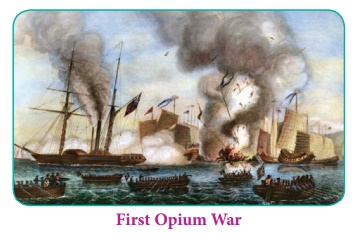
Opium Wars: The first Opium War was the result of China’s attempt to suppress
the illegal opium trade, as the human cost of the Chinese addiction was deadly.
British traders were the primary source of opium supply in China. The treaty of
Nanking signed at the end of first Opium War (1842) opened the doors to
Britain. China ceded Hong Kong and paid an indemnity.
The first war broke out when Chinese
officials boarded a British-registered ship, the Arrow, docked in Canton and arrested crew members for piracy. The
ship belonged to the Chinese, the crew were Chinese. But the ship flew the
British flag because of a permit from the Hong Kong government. The permit had
actually expired. Nonetheless the British government, which was looking for a
pretext to go to war so that it could force China into granting more trading
concessions, responded by sending a warship. Fighting broke out and France,
using the excuse of the murder of a French missionary (February 1856), joined
Great Britain. This time a British and French force destroyed the Summer Palace
in Peking. Finally, in 1860, China succumbed to the superior British military
strength and the Beijing Agreement was reached. It opened Chinese ports to
trade, allowed foreign ships down the Yangtze, and permitted the free movement
of foreign missionaries within China. Most importantly, it allowed the legal
trade of British opium within China.
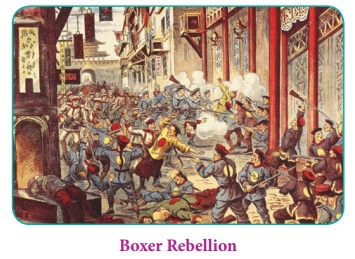
Boxer Rebellion (1899–1901): Boxer was a name that foreigners gave to a Chinese
secret society known as the Yihequan
(“Righteous and Harmonious Fists”). Although the Boxers came from all sections
of society, many were peasants, particularly from Shandong province, which had
been struck by natural disasters. The original aim of the Boxers was the
destruction of the Manchu dynasty and also of the Westerners who enjoyed a privileged
position in China. The Boxers burned churches and foreign residences and killed
suspected Chinese Christians on sight. A multi-national force, seized Peking,
as the Empress and her court fled. Nearly 100,000 people died. The great
majority of those killed were civilians, including thousands of Chinese
Christians and 200 to 250 foreign nationals (mostly Christian missionaries).
The Boxer Rebellion formally ended with the signing
of the Boxer Protocol on 7 September 1901. By the terms of the agreement, forts
protecting Beijing were to be destroyed. Boxers and Chinese government
officials involved in the uprising were to be punished. Foreign consulates were
permitted to station troops in Beijing for their defence. China was prohibited
from importing arms for two years and it was agreed to pay more than $330
million in reparations to the foreign nations concerned.
In October 1911 a mutiny broke out among the troops
in Wuchang. This is regarded as the formal beginning of the revolution. The
mutineers soon captured the Wuchang mint and arsenal, and city after city
declared war against the Manchus. Revolution broke out in the valley of the
Yangtze and soon spread to the greater part of central and south China. On New
Year’s Day 1912 the provinces involved in the revolt proclaimed a republic with
its capital at Nanking. On hearing the news of the uprising, Sun Yat-sen
arrived in Shanghai and was immediately elected provisional President of the
new Chinese Republic. Yuan Shih-kai, who had earlier served as a minister in
the Manchu administration, was recalled by the Regent who was acting for his
infant son to handle the revolt. But gauging the mood of the people Yuan
advised the abdication of the Emperor.
On February 12, 1912 an Edict of Abdication was
issued and the Manchu dynasty (Qing government) vanished from the Chinese
political stage. In the following month, Sun Yat-sen, in the interests of
unity, resigned in favour of Yuan, since the latter had total control over the
army.
Yuan Shih-kai’s Unpopularity
In the four years of his administration, Yuan
Shih-kai proved that he was opposed to both democracy and republicanism. Yuan
went on to ban the Kuomintang, the Nationalist Party, and seize the provinces
under its control. On 10 October 1913, Yuan was installed as the full-fledged
president of the republic. Exactly three months later, he dissolved the
National Assembly and replaced it with a "political council," which
drafted a "constitutional compact" granting dictatorial powers to the
president. Yuan was made president for life. Yuan became unpopular when he
agreed to the Japanese demand to have economic control of Manchuria and
Shantung. On the death of Yuan in 1916, a new president was appointed. For the
next twelve years the government was central only in name. It was a period of
disorder. Around this time Marxist ideas were gaining support in the north of
China, parallel to Sun-Yat-sen’s activities in the coastal cities between
Shanghai and Canton.
Sun Yat-sen (1866–1925)
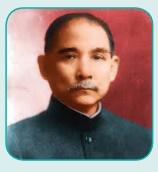
Dr. Sun Yat- sen, born in a poor
family, was educated in a mission school and became a medical doctor. His
interest in politics prompted him to participate in a rising against the Qing
government in 1895. The rising failed and Sun Yat-sen had to spend the next
sixteen years in exile. He spent his time in spreading his revolutionary ideas
amongst Chinese students and others living overseas. In 1905, he founded a
political party in Tokyo, which became the Kuomintang or National People’s
Party.
Sun-Yat-sen championed three principles:
Nationalism, Democracy, and Socialism. In 1894 Sun Yat-sen had founded the
China Revival Society that took exception to the “unequal treaties,” as the
Chinese called the two treaties forced on China by foreign powers. The society
grew and attracted the youth. By 1912, it had changed its name to the
Kuo-Min-Tang. Sun Yat -sen, the inspirer of the organisation, wanted a
republic, not a constitutional monarchy.
The Communist Party of China
With the death of Yuan Shih-kai during the First
World War, the country came to be divided by rival Chinese generals backed by
different powers. Many of the intelligentsia had faith in US liberalism to end
this state of affairs. But they felt let down as the expected did not happen.
The frustration was unleashed by millions of people through rallies and
demonstration in which students took prominent part. After the Russian
Revolution of 1917, the writings and speeches of Marx and Lenin became popular
amongst the intellectuals. Interest in Marxism grew as China’s emerging
industrial working class gained in strength and demonstrated it through strikes
and boycotts. In 1918 a Society for the Study of Marxism was formed in Peking
University. Among the students who attended was a young assistant librarian by
the name of Mao Tse-tung.
A series of strikes rocked China in 1922. About
2,000 seamen in Hong Kong, braving the proclamation of marital law, struck
work. It soon developed into a general strike of 120,000 workers forcing the
employers to opt for peace. Clashes between British police and workers in
British-owned factories in Hankou culminated in a warlord shooting down 35
striking rail workers and executing a union unit secretary. Such repressive
measures halted the onward march of the working class movement, but did not
destroy the spirit of resistance. Instead it led to an increasing level of
class consciousness.
By now Sun Yat-sen had established a constitutional
government. But its position was weak. So he sought USSR’s help to reorganise
his Kuomintang. USSR sent Michael Borodin to China. As an experienced Communist
Borodin reorganised the Kuomintang as a centralised mass party and helped to
build up a revolutionary army. The Whampoa Military Academy was founded near
Canton, with the assistance of Soviet officers. Its first director was Chiang
Kai-shek. On the staff in charge of political activities was Chou En Lai, as an
alliance had been formed between the Chinese Communist Party and the
Kuomintang.
Mao Tse-tung (1893–1976)
Mao was born in Hunan in south-east
China. His father was a wealthy peasant, and a firm supporter of the Manchu
dynasty. Mao entered the junior college at Changsha in the year of the
revolution (1911). Mao joined the revolutionary army but soon left and enrolled
in the Teachers’ Training College in Changsha. He remained there until 1918,
spending long hours in the library. He then moved to Peking and served as an
assistant librarian in Peking University. In the following year Mao began his
full-fledged political activities as an organiser of Hunan and emerged as a
staunch Communist.
Kuomintang and Chiang Kai-Shek
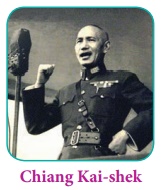
After the death of Sun Yat-sen in 1925, the
Kuomintang was organised on Communist lines, but it did not adopt Communist
policies. While the Kuomintang was led by Chiang Kai-Shek, the Communist Party
was under Mao Tse tung and Chou En Lai. The Communists increased their
influence among the workers and peasants, and won recruits for their army. The
Kuomintang represented the interests of the landlords and capitalists.
Chiang Kai-Shek began his march known as ‘the
Northern Expedition’ from Canton, and by the end of 1925, he had captured
Hanko. By March 1927, when the Expedition was approaching Shanghai, a general
strike involving 600,000 workers erupted and the unions had taken over the
control of the city. Chiang Kai-shek had already cracked down on the workers’
movement in Canton by arresting a number of communist activists and harassing
the unions. In Shanghai, after allowing the victorious rebel forces to hand him
the city, he treacherously arranged for the criminal gangs in collusion with
wealthy Chinese merchants and the representatives of the foreign powers to
launch a pre-dawn attack on the offices of the main left wing unions. The
workers’ sentries were disarmed and their leaders arrested. Demonstrations were
fired on with machine-guns, and thousands of activists died while fighting. At
the instance of wealthy merchants and financiers, Chiang Kai-Shek purged all
Communists from the Kuomintang Party. In 1928 he was successful in capturing
Peking. Once again there was a central government in China. But over the next
18 years his government became notorious for its corruption and gangsterism.
Mao knew that the Kuomintang grip on the towns was
too strong. So concentrated his energies on organizing the peasantry. He
retreated into the wild mountains on the border between the provinces of
Kiangsi and Hunan. Here Mao and his comrades stayed for the next seven years.
As the army of Mao was gradually growing, despite five extermination campaigns,
the Kuomintang was never able to penetrate the mountains successfully. In the
new base of the communists, they had protection from the attacks of Chiang
Kai-Shek, and an advantage in dealing with constant threat from Japan and also
the attacks from war lords.
The Long March 1934
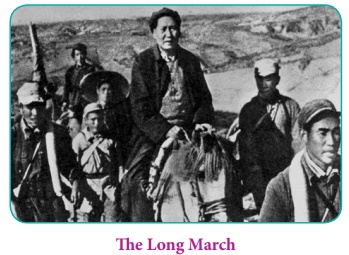
As Chiang Kai-Shek had built a circle of fortified
posts around the Communist positions, Mao wanted to move out of Hunan for safer
territory. Therefore, the Communist army set out on what came to be known as
the Long March in 1934. The marchers were continually harassed by Kuomintang
forces, by local war lords and by unfriendly tribesmen. The machine gun fire of
Kuomintang contingents and the deafening roar of the river caused horror to the
marchers. Of the 100,000 who set out, only 20,000 finally arrived in northern
Sheni late in 1935, after crossing nearly 6000 miles. They were soon joined by
other communist armies, and by 1937 Mao Tse-tung was the ruler of over 10
million people. Mao organised Workers and Peasants’ Councils in the villages of
Shensi and Kansu and the base for the eventual Communist conquest of China was
established.
Japanese Aggression and its Fallout
The Japanese continued to occupy north Chinese
provinces while developing Manchuria as a military base. Mao believed that
Chiang Kai-shek was necessary for some time to hold together Kuomintang to
fight the Japanese. As a consequence of this pragmatic policy, the attacks on
the Communists gradually petered out. However, a stronger line was adopted
towards Japanese expansion. Yet the Japanese had occupied the whole of the
eastern half of China during the Second World War, as the Kuomintang armies
fell easily. Chiang Kai-shek’s capital had to be shifted to Chungking.
Victory to Communists
With the announcement of the Japanese surrender in
1945 after the bombing of Hiroshima and Nagasaki, both the groups in China took
immediate steps to occupy the Japanese areas. In the course of this race, the
USA advised both sides to negotiate. During 1946 General George Marshall twice
negotiated ceasefires, but both were unsuccessful. The Kuomintang government
controlled the administration, ports and communication system in view of
themassive support provided by the USA.But the Kuomintang soldiers, mainly
drawn from the peasants, were Mao disillusioned and discontented. Mao, on the
other hand, had an army with higher morale and better discipline. When civil
war broke out, Chiang Kai-Sehik’s army began to disintegrate, with generals
changing sides. Cities fell one by one. By the end of 1949 Chiang Kai-Shek had
fled the mainland for Taiwan. The People’s Republic of China was established in
1949.
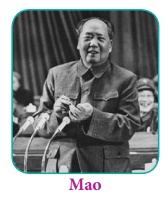
Related Topics